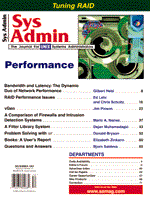
Questions and Answers
Bjorn Satdeva
I have created an "incoming" directory that has access permission set to write-only and owner to root. Visitors to our ftp site now can write to the "incoming" directory but are unable to see the contents of that directory. However, if someone knows the name of a file in the "incoming" directory, this person could download the file and read it.
If you use symbolic links to a writeable partition elsewhere, then some of programs that are offering services or that are used to maintain the system will break. For example, vipw and inetd will break (at least that was what happened in the version of UNIX for which I tried this), Unfortunately, if you do not have the sources to the operating system, it might be difficult to patch these programs to look for their configuration files in their new location. Nevertheless, for systems where you are especially concerned about security, such as servers living outside your security perimeter, it might be a good idea to do this. If you decide to use this method more generally, then there is a less obvious payoff, which is the ease of performing updates. Although you will need to burn a new CD in order to perform an upgrade, the upgrade itself will consist of shutting the system down, replacing the CD-ROM, and then rebooting the system. This simplifies the update procedure and ensures much better version control of the systems. This payoff might be of value for systems in remote locations without much local support. Oh, and one more word on security, when all executables are located on the CD-ROM, then it is impossible for an intruder to modify those executables. However, that does not mean that the system cannot be modified, and that it is bulletproof against intrusions. While it becomes vastly more difficult, it is still possible to make modifications that affect the security of the system. For example, in a demo I once did for a company, showing a weakness in their CD-ROM based firewall, I built a trojan horse, which broke the system, using the overlay and memory filesystems to hide it. So, while using a CD-ROM definitely increases security and makes it more difficult to modify the system, it does not make such modifications impossible.
For example, you can use this process to hide the fact that you are using PGP from automatic detection systems that are looking to somehow act upon your message if it contains the tell-tale BEGIN PGP MESSAGE delimiter or other attributes of a typical PGP message. Steganography does this by converting the PGP-encrypted binary file into nonsense English sentences, such as those below (truncated due to space constraints): My forthright hatchet won't flinch unless I flub. Let's glitter near the customary birminghams, but don't countervail the customary concords. I countervail mawkish layups near the adjoint earnest shenandoah. I'd rather clatter aborning than traject with a colicky nasturtium. Tell the fluid admiralty it's aborning abolishing against a limpet. Many rapt duplex northerners will bemoan edgeways to rollbacks. Have a nervy blot. Many drunk amatory papaws will engraft horribly to hints. Where is the grill for the wobbly discovery? The chits, ploughs, and concords are all burglarproof and foolproof.... If you are in search of more information about steganography, take a look at these URLs:
http://www.iquest.net/~mrmil/stego.html http://adams.patriot.net/~johnson/html/neil/stegdoc/stegdoc.html http://adams.patriot.net/~johnson/html/neil/sec/sbib00.htm" http://www.voicenet.com/~markm/crypt.html#stego
I will not, in this space, recommend a specific vendor, as I only do so when I have recent experience that indicates a recommendation or honorable mention is appropriate. I will go as far as to recommend choosing a company that provides a tape management system that also is a frontend for the UNIX dump command, rather than one which uses its own proprietary solution. A few years back I had a funny experience with a well-known backup software vendor, which uses a proprietary solution. After I had demonstrated a major problem in their implementation, I was told by one of their staff that "it was OK, it was still the fastest solution around." Backups are done for one reason only, so we can retrieve the information at a later time. If a given backup solution cannot retrieve the information, or if, as in this case, it is possible to destroy the tape index library, making it very difficult to retrieve data, the solution is not much different from not doing the backup in the first place. If you are looking for a freeware solution, there are two excellent packages, amanda and deejay, both of which are available from the ftp archives:
ftp://ftp.sysadmin.com/pub/admin/backup
Here you will also find the backup torture program. This program tests the reliability of backups and was the killer of the commercial package mentioned above.
About the AuthorBjorn Satdeva is the president of /sys/admin, inc., a consulting firm which specializes in large installation system administration. Bjorn is also co-founder and former president of Bay-LISA, a San Francisco Bay Area user's group for system administrators of large sites. Bjorn can be contacted at /sys/admin, inc., 2787 Moorpark Ave., San Jose, CA 95128; electronically at bjorn@sysadmin.com; or by phone at (408) 241-3111.
|